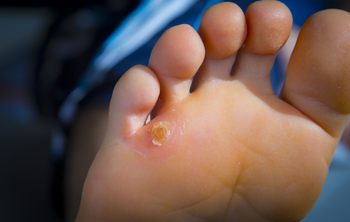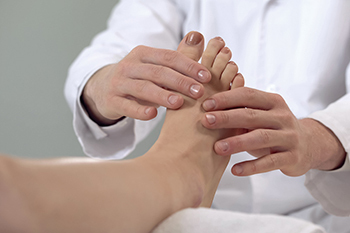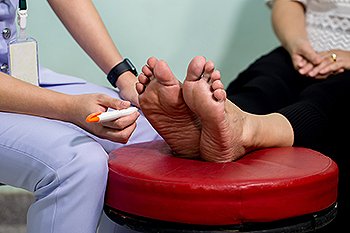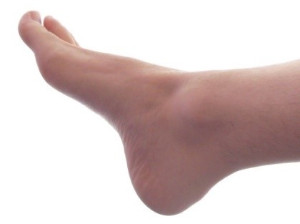Blog
Duration of Corns on the Feet

Corns can develop on one’s feet as a protective mechanism against friction or pressure. Corns typically have a dense core at the center, and they come in different types (hard corns and soft corns). Many individuals living with corns on the feet will not notice any symptoms associated with their condition. Others, however, might experience pain or irritation when walking. Patients with corns on the feet often wonder how long this condition typically lasts. Although it can vary from case to case, corns could be a long-term problem if nothing is done to address the cause. For instance, if you continue to wear ill-fitting footwear that rubs against your skin, this can exacerbate the emergence of corns. Additionally, if you can not correct problems in your gait that subject specific parts of your feet to friction or pressure, this can increase the risk of developing corns. If you have corns, it is a good idea to contact a podiatrist today for treatment.
If you have any concerns regarding your feet and ankles, contact Genine Befumo, DPM of University Foot and Ankle Center, L.L.C. Our doctor will treat your foot and ankle needs.
Corns: What Are They? and How Do You Get Rid of Them?
Corns can be described as areas of the skin that have thickened to the point of becoming painful or irritating. They are often layers and layers of the skin that have become dry and rough, and are normally smaller than calluses.
Ways to Prevent Corns
There are many ways to get rid of painful corns such as wearing:
- Well-fitting socks
- Comfortable shoes that are not tight around your foot
- Shoes that offer support
Treating Corns
Treatment of corns involves removing the dead skin that has built up in the specific area of the foot. Consult with Our doctor to determine the best treatment option for your case of corns.
If you have any questions please feel free to contact our office located in Monroe Township, NJ . We offer the newest diagnostic and treatment technologies for all your foot and ankle needs.
Effective Methods That May Help to Prevent Falling

Research has indicated that approximately 25% of people who are over 65 years old will experience a fall. This can result in a serious foot injury, such as a broken foot or ankle. People who have fallen may develop a fear of falling, which may lead to becoming inactive. There are methods that can be implemented that may help to reduce falling. These include having regular physical and eye examinations, and this is useful in updating existing medication and eyeglasses. Additionally, it is beneficial to install grab bars in the shower and toilet area, and it is safer while bathing when a bath mat is used. Many people improve the lighting in the household, and find it helpful to remove worn rugs that may be considered a tripping hazard. The feet can be affected by falling, and it is suggested that you consult with a podiatrist who can help you if that should happen
Preventing falls among the elderly is very important. If you are older and have fallen or fear that you are prone to falling, consult with Genine Befumo, DPM from University Foot and Ankle Center, L.L.C. Our doctor will assess your condition and provide you with quality advice and care.
Every 11 seconds, an elderly American is being treated in an emergency room for a fall related injury. Falls are the leading cause of head and hip injuries for those 65 and older. Due to decreases in strength, balance, senses, and lack of awareness, elderly persons are very susceptible to falling. Thankfully, there are a number of things older persons can do to prevent falls.
How to Prevent Falls
Some effective methods that older persons can do to prevent falls include:
- Enrolling in strength and balance exercise program to increase balance and strength
- Periodically having your sight and hearing checked
- Discuss any medications you have with a doctor to see if it increases the risk of falling
- Clearing the house of falling hazards and installing devices like grab bars and railings
- Utilizing a walker or cane
- Wearing shoes that provide good support and cushioning
- Talking to family members about falling and increasing awareness
Falling can be a traumatic and embarrassing experience for elderly persons; this can make them less willing to leave the house, and less willing to talk to someone about their fears of falling. Doing such things, however, will increase the likelihood of tripping or losing one’s balance. Knowing the causes of falling and how to prevent them is the best way to mitigate the risk of serious injury.
If you have any questions, please feel free to contact our office located in Monroe Township, NJ . We offer the newest diagnostic and treatment technologies for all your foot care needs.
What Is a Plantar Fibroma?

A plantar fibroma is a fibrous nodule in the arch of the foot that is noticeable and firm to the touch. It is embedded in the plantar fascia, the band of tissue that runs from the heel to the toes on the bottom of the foot. This can occur in one or both feet, it is usually a benign development, and it can remain the same size, get bigger, or multiply over time. This problem may or may not cause pain, but when pain is felt, it is often due to shoes pushing up against the lump in the arch. Pain can also arise when walking or standing barefoot. Specific causes for this condition have not been identified. Nonsurgical treatment, such as steroid injections, orthotics, or physical therapy, may help relieve pain of a plantar fibroma, but it will not make the mass go away. Surgical removal of the fibroma can be considered if nonsurgical approaches do not work, but this can lead to a flat foot or hammertoes. This condition has a high incidence of recurrence, and it is suggested that you see a podiatrist if you think that you have a plantar fibroma to confirm the diagnosis and get a professional opinion on the right treatment for you.
A plantar fibroma may disrupt your daily activities. If you have any concerns, contact Genine Befumo, DPM of University Foot and Ankle Center, L.L.C. Our doctor can provide the care you need to keep you pain-free and on your feet.
Plantar Fibroma
A plantar fibroma is a fibrous knot in the arch of the foot. It is embedded in the plantar fascia which is a band of tissue that extends from the heel to the toes along the bottom of the foot. There can be multiple plantar fibromas in the feet at the same time. There are no known causes for this condition. If you have a plantar fibroma, there will be a bump in the arch of your foot that cannot be missed. Any associated pain is most often due to a shoe rubbing against the nodule. Non-surgical options, such as steroid injections, physical therapy, and orthotics should be tried first. Surgery is a last resort and is the only thing that will remove a plantar fibroma entirely. Consult with a podiatrist for a proper diagnosis and to determine the treatment regimen that is right for you.
What Causes a Plantar Fibroma?
While there are no specific causes identified, a plantar fibroma can possibly come from genetic predisposition or the formation of scar tissue that forms from healing the tears in the plantar fascia.
What Are the Symptoms of a Plantar Fibroma?
There will be a noticeable lump in the arch of the foot that may or may not cause pain. If pain is felt, it is typically because a shoe is rubbing up against the lump or when walking or standing barefoot.
Treatment and Prevention
A plantar fibroma will not disappear without treatment, but it can get smaller and be a non-issue. If pain persists, a podiatrist examines the foot and when the arch of the foot is pressed, pain can be felt down to the toes. An MRI or biopsy might be performed to help diagnose or evaluate the plantar fibroma. The following non-surgical options are generally enough to reduce the size and pain of these nodules:
- Steroid injections
- Orthotics
- Physical therapy to help apply anti-inflammatory creams on the bump
Surgery is considered if the mass increases in size and the patient continues to feel pain after non-surgical methods are tried.
If you have any questions please feel free to contact our office located in Monroe Township, NJ . We offer the newest diagnostic tools and technology to treat your foot and ankle needs.
When to See a Podiatrist

A podiatrist is a doctor that treats the foot, ankle, and any connecting leg parts. They are known as a doctor of podiatric medicine or DPM, and these initials will appear after their name. Podiatrists must complete four years of study and training at a podiatric medical school. After this, they must complete residency training for three more years in a hospital or clinic. When they pass all required exams, they are certified by the American Board of Podiatric Medicine (APMA). Some of these doctors choose to specialize (such as in surgery, sports medicine, or pediatrics), and if they do this, they must obtain more training in their area of specialty. Podiatrists must be licensed in the state that they work in, and like other physicians, they must renew their licenses and keep up to date with their training. Like a family doctor or general care physician, unless they specialize, podiatrists treat people of all ages and for a range of conditions. If your feet hurt or if you have sustained an injury to your feet or ankles, it is time to see a podiatrist who can diagnose the problem and provide appropriate treatment. It is a good idea to have your feet checked by this type of doctor periodically anyway. Remember, your feet support your weight and get you through a lifetime of mobility.
If you are experiencing pain in the feet or ankles, don’t join the stubborn majority refusing treatment. Feel free to contact Genine Befumo, DPM from University Foot and Ankle Center, L.L.C. Our doctor can provide the care you need to keep you pain-free and on your feet.
What Is a Podiatrist?
Someone would seek the care of a podiatrist if they have suffered a foot injury or have common foot ailments such as heal spurs, bunions, arch problems, deformities, ingrown toenails, corns, foot and ankle problems, etc.
Podiatric Treatment
A podiatrist will treat the problematic areas of the feet, ankle or lower leg by prescribing the following:
- Physical therapy
- Drugs
- Orthotic inserts or soles
- Surgery on lower extremity fractures
A common podiatric procedure a podiatrist will use is a scanner or force plate which will allow the podiatrist to know the designs of orthotics. Patients are then told to follow a series of tasks to complete the treatment. The computer will scan the foot a see which areas show weight distribution and pressure points. The podiatrist will read the analysis and then determine which treatment plans are available.
If you have any questions please feel free to contact our office located in Monroe Township, NJ . We offer the newest diagnostic and treatment technologies for all your foot and ankle needs.
Corns and Calluses on the Feet of Athletes

Corns and calluses result from too much pressure on an area of the foot. Though they can occur in anyone, athletes are more prone to get them because the pressure on their feet is higher. Reasons for the development of corns and calluses can come from shoes if a deformity, such as bunion or hammertoe is present and rubs against the shoes. If the pressure is higher under the ball of the foot, it may be due to a prominent metatarsal head. Thickened skin of a corn or callus can be removed and provide relief from pain, but the only way to get rid of these symptoms permanently or prevent them from coming back is to remove what caused them in the first place. For example, if a corn develops from a hammertoe, fixing the hammertoe will get rid of the pressure and the corn will not come back. If you suffer from corns or calluses, see a podiatrist for help in figuring out what to do to remove the cause so these are no longer a problem for you.
Ankle and foot injuries are common among athletes and in many sports. They can be caused by several problems and may be potentially serious. If you are feeling pain or think you were injured in a sporting event or when exercising, consult with Genine Befumo, DPM from University Foot and Ankle Center, L.L.C. Our doctor will assess your condition and provide you with quality foot and ankle treatment.
Common Injuries
The most common injuries that occur in sporting activities include:
- Achilles Tendonitis
- Achilles Tendon Rupture
- Ankle Sprains
- Broken Foot
- Plantar Fasciitis
- Stress Fractures
- Turf Toe
Symptoms
Symptoms vary depending upon the injury and in some cases, there may be no symptoms at all. However, in most cases, some form of symptom is experienced. Pain, aching, burning, bruising, tenderness, tightness or stiffness, sensation loss, difficulty moving, and swelling are the most common symptoms.
Treatment
Just as symptoms vary depending upon the injury, so do treatment options. A common treatment method is known as the RICE method. This method involves rest, applying ice, compression and elevating the afflicted foot or ankle. If the injury appears to be more serious, surgery might be required, such as arthroscopic or reconstructive surgery. Lastly, rehabilitation or therapy might be needed to gain full functionality in the afflicted area. Any discomfort experienced by an athlete must be evaluated by a licensed, reputable medical professional.
If you have any questions, please feel free to contact our office located in Monroe Township, NJ . We offer the newest diagnostic and treatment technologies for all your foot care needs.
What Diabetics Need to Know About Foot Care

Diabetics have high blood sugar levels that can damage blood vessels and nerves in the legs and feet. Such damage can make it hard to feel pressure, pain, and temperature in the feet. Therefore, diabetics may not know they have a cut or sore on their foot or feel the effects of shoes that are not fitting properly. Diabetes can cause the toes to become crooked or curved under and this can impact the way one walks, leading to more pressure on the foot. The increased pressure can reduce blood flow to the feet which increases the risk of foot ulcers. Diabetics need to practice regular foot care to prevent serious problems such as an infection, gangrene, or even amputation. Regular foot care involves checking the feet daily for wounds, corns, or calluses as well as changes in skin texture, color, or temperature. Wash the feet each day with warm, soapy water and dry them, followed by applying a moisturizer. Finish by trimming the toenails straight across and wear well-fitting shoes with clean, dry socks. If you are diabetic it is suggested to have a professional foot exam once a year or whenever you notice a change in your feet. A podiatrist can monitor your feet over time as well as care for any problems that may arise.
Diabetic foot care is important in preventing foot ailments such as ulcers. If you are suffering from diabetes or have any other concerns about your feet, contact Genine Befumo, DPM from University Foot and Ankle Center, L.L.C. Our doctor can provide the care you need to keep you pain-free and on your feet.
Diabetic Foot Care
Diabetes affects millions of people every year. The condition can damage blood vessels in many parts of the body, especially the feet. Because of this, taking care of your feet is essential if you have diabetes, and having a podiatrist help monitor your foot health is highly recommended.
The Importance of Caring for Your Feet
- Routinely inspect your feet for bruises or sores.
- Wear socks that fit your feet comfortably.
- Wear comfortable shoes that provide adequate support.
Patients with diabetes should have their doctor monitor their blood levels, as blood sugar levels play such a huge role in diabetic care. Monitoring these levels on a regular basis is highly advised.
It is always best to inform your healthcare professional of any concerns you may have regarding your feet, especially for diabetic patients. Early treatment and routine foot examinations are keys to maintaining proper health, especially because severe complications can arise if proper treatment is not applied.
If you have any questions please feel free to contact our office located in Monroe Township, NJ . We offer the newest diagnostic and treatment technologies for all your foot and ankle needs.
What Is a Heel Spur?

A heel spur is a growth of bone that forms from extra calcium deposits on the foot and that stretch from the heel bone to the foot arch. It is one of the most common causes of heel pain. Heel spurs are a quarter of an inch in length or smaller, though they may become larger in some cases. They cannot be seen from outside of the body but can become quite painful, especially when jumping, running, or walking. There may be swelling of the heel and ankle with heel spurs. Some of the primary causes of heel spurs are ill fitting or non-supportive footwear, wearing high heels, bruising under the heel bone, poor posture or other physical structural issues (such as flat feet or high arches), or being overweight or obese. Other possible causes are having a pre-existing medical condition, like diabetes or arthritis, over-training, repetitive hard impact or pressure on the heel, and aging with calcium leaving the bones and settling into the bloodstream and attaching to the surface of bones. Women are more prone to developing heel spurs than men because their hips are naturally wider in comparison to their knees which causes additional pressure to be placed on the heel with movement. Routine foot care and exercises to reduce ligament stress and relieve bone tension will help invigorate heel tissues, but sometimes surgery will be required to remove a heel spur. If you have a heel spur and it is causing pain and interfering with your functioning, consult with a podiatrist who can recommend the best course of treatment.
Heel spurs can be incredibly painful and sometimes may make you unable to participate in physical activities. To get medical care for your heel spurs, contact Genine Befumo, DPM from University Foot and Ankle Center, L.L.C. Our doctor will do everything possible to treat your condition.
Heels Spurs
Heel spurs are formed by calcium deposits on the back of the foot where the heel is. This can also be caused by small fragments of bone breaking off one section of the foot, attaching onto the back of the foot. Heel spurs can also be bone growth on the back of the foot and may grow in the direction of the arch of the foot.
Older individuals usually suffer from heel spurs and pain sometimes intensifies with age. One of the main condition's spurs are related to is plantar fasciitis.
Pain
The pain associated with spurs is often because of weight placed on the feet. When someone is walking, their entire weight is concentrated on the feet. Bone spurs then have the tendency to affect other bones and tissues around the foot. As the pain continues, the feet will become tender and sensitive over time.
Treatments
There are many ways to treat heel spurs. If one is suffering from heel spurs in conjunction with pain, there are several methods for healing. Medication, surgery, and herbal care are some options.
If you have any questions feel free to contact our office located in Monroe Township, NJ . We offer the latest in diagnostic and treatment technology to meet your needs.
A Stress Fracture Can Be Called a Fatigue Fracture

A stress fracture in the foot is common among people who enjoy running and participating in sporting activities. It is considered to be a hairline fracture, and gradually happens from repetitive stress that is put on the bones in the feet. People may refer to it as a fatigue fracture, and it is a weakening of the bone. There may be additional risk factors at play in why some people develop stress fractures and others do not. These can include not consuming enough calories, having an earlier stress fracture, or possibly from having low body weight. Many people can endure a stress fracture from training too rapidly and frequently, as this does not allow adequate time for the bones to get used to the added stress. Additionally, if running is done on hard surfaces, it may contribute significantly to getting a stress fracture. Relief generally begins with stopping the activity that caused the fracture, and resting the affected foot which may help to relieve swelling. If you have endured a stress fracture, it is advised that you speak with a podiatrist as quickly as possible so the correct treatment can begin.
Stress fractures occur when there is a tiny crack within a bone. To learn more, contact Genine Befumo, DPM from University Foot and Ankle Center, L.L.C. Our doctor can provide the care you need to keep you pain free and on your feet.
How Are They Caused?
Stress fractures are the result of repetitive force being placed on the bone. Since the lower leg and feet often carry most of the body’s weight, stress fractures are likely to occur in these areas. If you rush into a new exercise, you are more likely to develop a stress fracture since you are starting too much, too soon. Pain resulting from stress fractures may go unnoticed at first, however it may start to worsen over time.
Risk Factors
- Gender – They are more commonly found in women compared to men.
- Foot Problems – People with unusual arches in their feet are more likely to develop stress fractures.
- Certain Sports – Dancers, gymnasts, tennis players, runners, and basketball players are more likely to develop stress fractures.
- Lack of Nutrients – A lack of vitamin D and calcium may weaken the bones and make you more prone to stress fractures
- Weak Bones – Osteoporosis can weaken the bones therefore resulting in stress fractures
Stress fractures do not always heal properly, so it is important that you seek help from a podiatrist if you suspect you may have one. Ignoring your stress fracture may cause it to worsen, and you may develop chronic pain as well as additional fractures.
If you have any questions, please feel free to contact our office located in Monroe Township, NJ . We offer the newest diagnostic and treatment technologies for all your foot care needs.
Blog Archives
- April 2024
- March 2024
- February 2024
- January 2024
- December 2023
- November 2023
- October 2023
- September 2023
- August 2023
- July 2023
- June 2023
- May 2023
- April 2023
- March 2023
- February 2023
- January 2023
- December 2022
- November 2022
- October 2022
- September 2022
- August 2022
- July 2022
- June 2022
- May 2022
- April 2022
- March 2022
- February 2022
- January 2022
- December 2021
- November 2021
- October 2021
- September 2021
- August 2021
- July 2021
- June 2021
- May 2021
- April 2021
- March 2021
- February 2021
- January 2021
- December 2020
- November 2020
- October 2020
- September 2020
- August 2020
- July 2020
- June 2020
- May 2020
- April 2020
- March 2020
- February 2020
- January 2020
- December 2019
- November 2019
- October 2019
- September 2019
- August 2019
- July 2019
- June 2019
- May 2019
- April 2019
- March 2019
- February 2019
- January 2019
- December 2018
- November 2018
- October 2018
- September 2018
- August 2018
- July 2018
- June 2018
- May 2018
- April 2018
- March 2018
- February 2018
- January 2018
- December 2017
- November 2017
- October 2017
- September 2017
- August 2017
- July 2017
- June 2017
- May 2017
- April 2017
- March 2017
- February 2017
- January 2017
- December 2016
- November 2016
- October 2016
- September 2016
- August 2016
- July 2016
- June 2016
- May 2016
- April 2016
- March 2016
- February 2016
- January 2016
- December 2015
- November 2015
- October 2015
- September 2015
- August 2015
- July 2015
- June 2015
- May 2015
- April 2015
- March 2015
- February 2015
- January 2015
- December 2014
- November 2014
- October 2014
- September 2014
- August 2014
- July 2014






